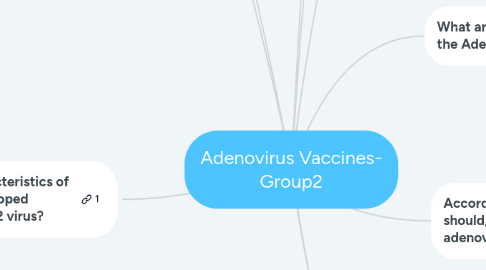
1. What are the characteristics of Adenoviruses developed against SARS-Cov-2 virus?
1.1. AZD1222 (ChAdOx1 nCoV-19)
1.1.1. Chimpanzee Adenovirus type Vector 63
1.1.2. Production Medium (origin): HEK-293A (Human embryo)
1.1.3. Sponsored by University of Oxford with AstraZeneca
1.1.4. Currently in clinical trial Phase 3
1.1.4.1. Preclinical trials in mice and rhesus macaques showed no signs of virus replication in the lungs, significantly lower levels of respiratory disease and no lung damage compared to control animals
1.1.4.2. Phase 1 trial began on April 23rd in the UK: an acceptable safety profile, and homologous boosting increased antibody responses
1.1.5. Age Studied to date: 5-12 and 18-55
1.1.6. Intramuscular route
1.1.7. Single dose or days 0 and 28-42
1.1.8. 0.5 mL injection contains about 50 billions viral particles
1.2. Ad26.COV2.S
1.2.1. Human Adenovirus type Vector 26
1.2.2. Production Medium (origin): PER.C6 (Human embryo)
1.2.3. Sponsored by Janssen Vaccines
1.2.4. Currently in clinical trial Phase 3
1.2.4.1. Phase 1/2a studies
1.2.4.1.1. Immune Response Data: 98 % of participants were positive for neutralizing antibodies against SARS-CoV-2 at day 29 post-vaccination. The vaccine produced strong antibody and T cell responses including a Th1 response, believed to be protective against the risk of vaccine-associated enhanced respiratory disease.
1.2.4.1.2. Safety and Tolerability: No life threatening adverse effects, and stronger reactions were associated with younger age and higher dose
1.2.4.2. Phase 3 Studies
1.2.4.2.1. Started in September 2020 and is set to be completed in March 2023
1.2.4.2.2. Estimated participants about 60,000
1.2.5. Age studied to date: 18-59, 60 and higher
1.2.6. Intramuscular route
1.2.7. Single dose or days 0 and 52
1.2.8. 0.5 mL injection contains about 50 billions viral particles
1.3. Ad5-nCov
1.3.1. Human Adenovirus type Vector 5
1.3.2. Production Medium (origin): HEK-293 (Human embryo)
1.3.3. Sponsored by CanSino biologics with Academy of Military Medical Sciences
1.3.4. Currently in clinical trial Phase 3
1.3.4.1. Phase 1
1.3.4.1.1. Vaccine is tolerated
1.3.4.1.2. Immunogenic 28 days post-vaccination: Humoral responses peaked at day 28 in healthy adults
1.3.4.1.3. Rapid specific T-cell responses were noted from day 14 post-vaccination.
1.3.4.2. Phase 2
1.3.4.2.1. Vaccine is safe
1.3.4.2.2. Induced significant immune responses in most participants
1.3.5. Age studied to date: 18 and higher
1.3.6. Intramuscular route
1.3.7. Single dose or days 0 and 52
1.3.8. could contain about 50 or 100 billions viral particles
2. How has the Adenovirus been used to create other vaccines?
2.1. The Adenovirus serves as a viral-vector.
2.2. Adenovirus originally showed promise as a gene replacement therapy vector due to their ability to be easily genetically modified.
2.2.1. However, there was not much that could be done because the hosts innate immune response.
2.2.2. This lead to the use of the Adenovirus being used as a vaccine vector for diseases where vaccine development has not been successful.
2.2.2.1. These diseases include TB and HIV.
3. What are some advantages of Adenoviruses vaccines over other conventional vaccines?
3.1. High transduction efficiency for different quiescent and dividing cell types
3.2. High levels of short-term expression to provide therapeutic benefits
4. What are some Adenovirus symptoms?
4.1. Common cold/Flu like symptoms
4.2. Fever
4.3. Sore Throat
4.4. Pneumonia
4.5. Diarrhea
4.6. Conjunctivitis
5. What are some features of the Adenovirus Vaccine?
5.1. contains live Adenovirus Type 4 and 7
5.2. Comes as two separate enteric-coated tablets
5.3. Each tablet contains one strain of the virus
5.4. Both tablets have to be taken together and orally
5.5. The enteric coated tablets pass through the acidic stomach remaining intact
5.6. They are released in the intestines where they replicate and induce active immunity
6. According to the FDA, who should/could receive the adenovirus vaccine?
6.1. Military populations age 17 through 50
6.2. Not available for use in other populations
7. Who should not receive an adenovirus vaccine?
7.1. History of Allergic reaction to any components of the vaccine
7.2. Pregnancy:
7.2.1. Pregnancy should be avoided 6 weeks after vaccination
7.2.2. Possibility of fetal harm: Natural adenovirus are associated with fetal harm
7.2.3. Vaccinees should avoid close contact with pregnant women for at least 28 days
7.3. Patients who cannot swallow
7.3.1. Do not chew tablets
7.3.2. If tablets are chewed, swish and swallow water followed by rinsing and spitting with antiseptic mouthwash
7.3.3. Seek medical care if fever and/or symptoms of respiratory infection
8. What other precautions should be considered in special populations ?
8.1. Immunocompromised: ACIP does not recommend the use of live vaccines
8.1.1. Cancer: could be administered if disease is in remission and chemotherapy was terminated at least 3 months prior
8.1.2. HIV: MILVAX states that administration is not contraindicated and screening is not necessary
